What foods can help the elderly people stay at home?
According to 2019 INSEE estimations, people over 75 years old represent up to one tenth of the French population.1 Among them, only 10% attend or live in a retirement home for elderly people.2 Therefore the majority of this population remains at home with varying dependencies.

With age, we can see lifestyle changes due to physical capacities decline and psychological state evolution. This may result in a decrease of physical activities and a dietary intake reduction. Weight loss can be important, which is not without risk for elderly people: diseases such as sarcopenia or osteoporosis could appear. 3 4
So, it is essential to provide food products designed for elderly people to ensure that their dietary intake remains adequate. Indeed, these can be important in order to maintain adequate dietary intakes and therefore maintain a healthy lifestyle.
An American statistical study of 2018 revealed that a healthy lifestyle (good and adequate eating habits, moderate alcohol consumption, etc…) could potentially increase life expectancy by 12.2 years for men and 14 years for women.5 For comparison, the average life expectancy in the United Stated is 78.5 years old (2017 data).6
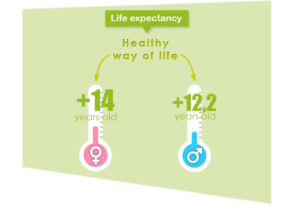
Why do we need products that are “adapted” to elderly people? Are common products not enough?
Common food products should of course not be removed. But a lot of studies demonstrate that dietary intake strongly tends to decrease with age. 3 7 8 9 Between 20 and 80 years old, we estimate that energy intake decreases about 600 and 1 300kcal respectively for women and men. 10 This represents an average energy intake reduction of up to 50%. Such a decrease is not without any consequences for the body: cognitive and physical capacities reduction, fatigue increase, weakening of the immune system, etc… Indeed, a 2018 meta-analysis showed that the quality of life of older adults was directly associated to their eating habits. 11
Consequently, dietary supplements can be necessary in order to better cover energy need of elderly people. Then, three types of products exist:
- Nutritional supplement; they can be useful to provide vitamins, minerals and other essential nutrients such as omega-3. The main disadvantage of these is that they can be difficult to swallow for some elderly people, especially those with dysphagia (swallowing difficulties). Moreover, these products may be seen as drugs by elderly people. This is the reason why some aversion may be observed.
- Functional foods, i.e. foods that appear to be similar to conventional foods, but they contain one or more health benefits nutrients.12 These foods can often contain a concentrate of essential nutrients. For example, they can be presented as dairy beverage, dessert cream or even soup.
- Finger-food products; these are traditional foods but with a shape and a consistency that allowed them to be eaten with fingers. These foods will usually be a concentrate of energy and essential nutrients. The advantage of these products is the fact that they are simple to eat for older adults with difficulties to use fork and knife (such as patients with Parkinson’s disease). Moreover, they can be easily added in a dish or be consumed at any time of the day without necessarily being at the dinner table.

What are the most important nutrients for these products adapted to elderly people?
We have already seen that energy intake of elderly people is often insufficient. Consequently, a product intended for this population could be concentrate in energy. Then it could be richer in fats, because lipid is the most energetic nutrient: carbohydrates and proteins approximately represent 4kcal/g while lipids represent 9kcal/g. Concerning the quality of these lipids, it would be ideal to maximize omega-3 since it is an essential fatty acid that is too little present in the traditional diet. Various epidemiological studies have shown that increased consumption of omega-3 would reduce the risk of stroke as well as cognitive declines. 10 13 14
Proteins are also extremely important for elderly people because they help maintain bone and muscle mass integrity. This allows this population to better preserve their physical capacities. For more information, we talk about this topic in several blog article:
- “What are the protein needs of the elderly?“
- “What is the perfect protein for the elderly people?“
- “How are proteins beneficial to bone health?“

With age, anabolic A resistance can occur. In other words, a small quantity of proteins could not be enough to stimulate muscular synthesis.15 However, it is still possible to counterbalance the phenomenon by providing a biggest quantity of essential amino acids B, especially Leucine, the most important amino acid to enhance anabolism.16 17 Therefore, a dose of between 2 and 3g would represent the minimum amount per food intake to properly stimulate muscular synthesis in the elderly people. 15 18 19
Furthermore, it is important to notice that food alone is not enough: physical activity (even walking) is essential in order to maintain the muscle stimulation. For more information, please see our article on protein needs of elderly people.

The addition of micronutrient can also be important. According to recommendations from the 2016 review “Nutrition recommendations in elderly and aging. Medical Clinics of North America”, the lack of certain nutrients may pose a health risk. Nutrients that are commonly deficient are vitamin D and B12, and Calcium. These are the three micronutrients to be included as a priority in products for elderly people.19
If food products are more energetic, are elderly people likely to eat less?
No, they are not, provided that the dish volume does not change. A study conducted in a hospital on 36 patients aged from 52 to 96 years old found that the food volume ingested between a regular dish and a dish with a higher energy density is negligible. Therefore, it is possible to significantly increase energy intake by providing food products high in energy. 20
What foods should be included in these products adapted to elderly people?
Not all foods are suitable for elderly people. Not for health reasons, but simply for the hedonic side of the product. As we have seen earlier, there is often an appetite decline with age. That is the reason why the product must be as appetizing as possible so that the elderly person wants to consume it.8
A 2008 study of the Journal of Nutrition Health and Aging indicates that the more negative emotion is generated by food (disgust, indifference, worry, doubt, frustration, disappointment, fatigue), the greater the risk of undernutrition may be. So, it appears essential to choose foods that generate positive emotions in this population. 21
What foods can elicit these positive emotions in elderly people?
A 2006 study shows that elderly people’s favorite dishes seem to be foods they are familiar with, with a traditional way of preparation. So, we have to forget overelaborated methods of preparation and exotic foods. It Is important to use what they know well and appreciate. 22
Therefore, flavorings should always remain simple: vanilla, chocolate, caramel, coffee… Furthermore, sensory abilities often decrease with age. As taste and smell may weaken, it seems necessary to raise the flavors of foods more and to propose stronger aromas than those traditionally used.
Do these foods have to meet specific requirements?
In addition to the nutrition and hedonic aspect, these products must have a shape and a texture adapted. Indeed, elderly people can have certain diseases such as dysphagia or xerostomia (oral dryness). That is why product should have a particular texture. 23
It can be a good idea to make products in small portion form so that they can be eaten without cutlery. To this extent, finger-food products can be very interesting.

As a conclusion, to be perfectly adapted to elderly people, a food product must:
- Be energetic and source of essential nutrients, especially vitamins (D and B12), minerals (calcium) and proteins. Moreover, for proteins, it is important to choose a Leucine-rich one. That is the reason why dairy proteins can be very interesting: whey proteins contain 11.7% of Leucine, and micellar caseins 9.2%. *
- Be attractive, it must generate positive emotions. But it should not be too extravagant: older people generally prefer products that are familiar to them.
- Be easy to consume, with a suitable texture and shape (not too hard, not too dry for example)
*A [Anabolism]: Muscular protein synthesis
*B [Essential Amino Acids]: Amino acid that the body cannot synthesize. Therefore, they must be supplied through the diet
*data for Leucine correspond to those measured in Prodiet® 80S for whey proteins and Prodiet® Fluid for micellar caseins. These products are developed by Ingredia.
For more information and any inquiry, contact us.
Authors: Rémi Maleterre & Audrey Boulier.
_________________________________________________________________________________________
[1] “Population Par Âge − Tableaux de l’économie Française | Insee,” accessed April 9, 2020, https://www.insee.fr/fr/statistiques/3676587?sommaire=3696937.
[2] DREES, “728 000 Résidents En Établissements d’hébergement Pour Personnes Âgées En 2015,” Études & Résultats, 2015, https://drees.solidarites-sante.gouv.fr/IMG/pdf/er1015.pdf.
[3] Sonya Brownie, “Why Are Elderly Individuals at Risk of Nutritional Deficiency?,” International Journal of Nursing Practice 12, no. 2 (2006): 110–18, https://doi.org/10.1111/j.1440-172X.2006.00557.x.
[4] Alfonso J. Cruz-Jentoft et al., “Prevalence of and Interventions for Sarcopenia in Ageing Adults: A Systematic Review. Report of the International Sarcopenia Initiative (EWGSOP and IWGS),” Age and Ageing 43, no. 6 (November 1, 2014): 748–59, https://doi.org/10.1093/ageing/afu115.
[5] Yanping Li et al., “Impact of Healthy Lifestyle Factors on Life Expectancies in the US Population,” Circulation, July 2018, https://doi.org/10.1161/CIRCULATIONAHA.117.032047.
[6] “Indicateurs de Développement Dans Le Monde – Google Public Data Explorer,” accessed August 30, 2020, https://www.google.com/publicdata/explore?ds=d5bncppjof8f9_&met_y=sp_dyn_le00_in&idim=country:USA:GBR:CAN&hl=fr&dl=fr#!ctype=l&strail=false&bcs=d&nselm=h&met_y=sp_dyn_le00_in&scale_y=lin&ind_y=false&rdim=world&idim=country:USA&ifdim=world&hl=fr&dl=fr&ind=false.
[7] J. E. Morley, “Decreased Food Intake With Aging,” The Journals of Gerontology Series A: Biological Sciences and Medical Sciences 56, no. Supplement 2 (October 1, 2001): 81–88, https://doi.org/10.1093/gerona/56.suppl_2.81.
[8] Anna Pilgrim et al., “An Overview of Appetite Decline in Older People,” Nursing Older People 27, no. 5 (June 2015): 29–35, https://doi.org/10.7748/nop.27.5.29.e697.
[9] Lorenzo M. Donini, Claudia Savina, and Carlo Cannella, “Eating Habits and Appetite Control in the Elderly: The Anorexia of Aging,” International Psychogeriatrics 15, no. 1 (March 2003): 73–87, https://doi.org/10.1017/S1041610203008779.
[10] Riccardo Calvani et al., “Current Nutritional Recommendations and Novel Dietary Strategies to Manage Sarcopenia,” The Journal of Frailty & Aging 2, no. 1 (2013): 38–53.
[11] Thara Govindaraju et al., “Dietary Patterns and Quality of Life in Older Adults: A Systematic Review,” Nutrients 10, no. 8 (July 26, 2018), https://doi.org/10.3390/nu10080971.
[12] karine Pierre-Lecocq, “Aliment fonctionnel,” CERIN, accessed April 9, 2020, https://www.cerin.org/glossaire/aliment-fonctionnel/.
[13] Institute of Medicine (US) Food Forum, Nutrition Concerns for Aging Populations, Providing Healthy and Safe Foods As We Age: Workshop Summary (National Academies Press (US), 2010), https://www.ncbi.nlm.nih.gov/books/NBK51837/.
[14] Natalia Ubeda, María Achón, and Gregorio Varela-Moreiras, “Omega 3 Fatty Acids in the Elderly,” The British Journal of Nutrition 107 Suppl 2 (June 2012): 3, https://doi.org/10.1017/S0007114512001535.
[15] Benoit Smeuninx et al., “Age-Related Anabolic Resistance of Myofibrillar Protein Synthesis Is Exacerbated in Obese Inactive Individuals,” The Journal of Clinical Endocrinology and Metabolism 102, no. 9 (July 14, 2017): 3535–45, https://doi.org/10.1210/jc.2017-00869.
[16] Imanipour Vahid et al., “The Effects of Branch-Chain Amino Acids on Fatigue in the Athletes,” Interventional Medicine & Applied Science 10, no. 4 (n.d.): 233–35, https://doi.org/10.1556/1646.10.2018.10.
[17] Joshua C. Anthony et al., “Orally Administered Leucine Stimulates Protein Synthesis in Skeletal Muscle of Postabsorptive Rats in Association with Increased EIF4F Formation,” The Journal of Nutrition 130, no. 2 (February 1, 2000): 139–45, https://doi.org/10.1093/jn/130.2.139.
[18] Christos S. Katsanos et al., “A High Proportion of Leucine Is Required for Optimal Stimulation of the Rate of Muscle Protein Synthesis by Essential Amino Acids in the Elderly,” American Journal of Physiology. Endocrinology and Metabolism 291, no. 2 (August 2006): E381-387, https://doi.org/10.1152/ajpendo.00488.2005.
[19] Hope Barkoukis, “Nutrition Recommendations in Elderly and Aging,” The Medical Clinics of North America 100, no. 6 (November 2016): 1237–50, https://doi.org/10.1016/j.mcna.2016.06.006.
[20] Ann Ödlund Olin et al., “Energy-Enriched Hospital Food to Improve Energy Intake in Elderly Patients,” Journal of Parenteral and Enteral Nutrition 20, no. 2 (1996): 93–97, https://doi.org/10.1177/014860719602000293.
[21] Issa Narchi et al., “Emotions Generated by Food in Elderly French People,” The Journal of Nutrition, Health & Aging 12 (February 1, 2008): 626–33, https://doi.org/10.1007/BF03008273.
[22] M. Laureati et al., “Sensory Acceptability of Traditional Food Preparations by Elderly People,” Food Quality and Preference, The First European Conference on Sensory Science of Food and Beverages: “A Sense of Identity,” 17, no. 1 (January 1, 2006): 43–52, https://doi.org/10.1016/j.foodqual.2005.08.002.
[23] E. Rothenberg and K. Wendin, “7 – Texture Modification of Food for Elderly People,” in Modifying Food Texture, ed. Jianshe Chen and Andrew Rosenthal (Woodhead Publishing, 2015), 163–85, https://doi.org/10.1016/B978-1-78242-334-8.00007-9.
Webinar on Healthy Ageing: growth request of protein in healthy ageing market
Elsa Trotier, Product Manager responsible for the range of nutritional proteins and Wenqian Sun, Nutritional Development Specialist at Ingredia, will discuss in a FREE webinar the growth request of protein in healthy ageing market.
Nowadays, population is getting older, in 2050, 2 billion of the global population will be more than 60 years (WHO). To support healthy ageing, many products are launched in senior nutrition. Most of them contain proteins. Seniors do not want to be categorized and want indulgent products as their counterpart.
Faced with these challenges, Ingredia offers solutions to meet targeted nutritional needs and technical support during your product development with our range of nutritional milk proteins PRODIET®.
Learn more and join us on Tuesday, November 24th, 1:45 P.M (French time) Save the date, register now!

How are dietary proteins beneficial to bone health?
Our physical abilities change throughout life. They gradually increase with age until their maximum between 20 and 30 years old.1 After a stagnation period, then there is a decline.2 The beginning of this stage depends on number of factors: genetic, food intake, physical activity, and the global health state.3 With age, complications may arise especially in bones. After the age of 50, it is not uncommon to see a progressive bone weakening: this is osteopenia.
Osteopenia? What is the difference between osteopenia and osteoporosis we hear about fairly regularly?
As shown in figure 1, it is possible to simplify the evolution of bone health degradation in 3 steps. Before the age of 50, mineral density is generally normal and bones are strong. Then the first complications appear: bones start to weaken and the fracture risk increase. This is osteopenia. At this point, the aim is to strengthen bone mass to delay osteoporosis as much as possible, even recover a good bone health. If nothing is done, bones will keep getting worse: this is the typical bone demineralization of osteoporosis (figure 2).4

Figure 1: Evolution of human bone health degradation from the age of 50.5

Figure 2: Bone density evaluation based on bone density score. The more this score is low, the more porous bones are.6
Do these complications concern everyone?
Yes, they do. With age, it is perfectly natural to observe a declining bone health. However, some factors can potentially increase the occurrence of this complications: sex (during their lifetime, more than half of women will on average have an osteoporotic fracture compared to only one third of men)7, exposition to certain harmful substances (alcohol, smoke), diet and physical activity.8
Is it possible to reduce the risk of bone fragility by changing your lifestyle?
Yes, you can, and we will especially focus on food. Indeed, it is well accepted that calcium and vitamin D are absolutely essential to bone health. That’s why recommended daily intake of calcium are about 1200mg/d and 10µg/j for vitamin D from the age of 50.9
However, these are not the only essential nutrients to consider. A study from « Current Osteoporosis Report » show that numbers of nutrients (figure 3) are beneficial to bone health, such as proteins.10
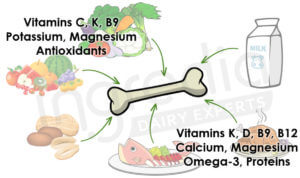
Figure 3: Nutrients acting positively on bone health.10
Can proteins be beneficial to bone health? I thought it was the opposite…
This is a common misconception. Before demonstrating their beneficial effects on bone health, it was first observed that dietary proteins cause an increase of urinary calcium. That is the reason why we firstly think that proteins could be harmful to bone health because they may generate bone demineralization.11
But this conclusion was far too hasty: even if an increase of dietary protein consumption generates an increase of urinary calcium, at the same time they enhance intestinal calcium absorption. This has been proven in 2003 study from the « American Journal of Clinical Nutrition ». As shown in figure 4, a high protein diet (2.1g/kg of body weight) allow to reach an intestinal calcium absorption of 26.3% against only 18.4% for a lower protein diet (0.7g/kg of body weight). This represents a significant increase of calcium absorption of 43%.12 13
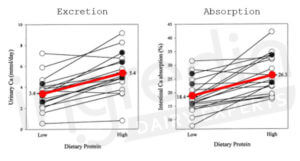
Figure 4 : Individual changes in 24h of urinary calcium and intestinal calcium absorption in response of à low- (0.7g/kg) and high- (2.1g/kg) protein diet in 20 healthy women.12 13
According to the figure 4, the high-protein diet (2.1g/kg) increase urinary calcium excretion by 2 mmol on 24h (3.4 to 5.4 mmol/d).
Knowing the calcium daily intake in the prescribed diet during the study (20 mmol/d), it is possible to deduce the amount absorbed with the low- (0.7g/kg) and the high- (2.,g/kg) protein diet: 3.7mmol with the first (18.4% of 20 mmol) and 5.3 mmol with the second one (26.3% of 20 mmol). Consequently, the high-protein diet enables to absorb 1.6 mmol more calcium in 24h.12
As a result, most of the increase in calcium excretion is explained by an increase in its intestinal absorption.
But it is not just about the calcium excretion: it is said that proteins are considered as “acidic” for the body, and this promotes bone demineralization. Is that true?
It is true that we commonly consider proteins as “acidic” for the body, in contrast to vegetables considered as “alkaline”. But the question is: does an “acidic” or “alkaline” diet have an impact on bone health? This we the topic of a 2013 review conducted by Hanly & Whiting. They summarize results from different articles and they concluded that evidences supporting the role of proteins in the development of osteoporosis are not consistent. At the same time, the authors found that a more “alkaline” diet does not appear to be particularly more beneficial for bone health.14
To summarize this review, there is no link between bone health and an “acidic” or “alkaline” diet.

Fine, but then how does proteins affect bone health? Bones are not made of protein…
And yet it is false: contrary to a common misconception, bones are not only composed of inert material: they contain proteins such as collagen.15 Like all proteins, they breakdown and regenerate perpetually: this is the protein turn-over. We studied more precisely this subject in our blog article “Why do endurance athletes need more protein?”. Consequently, a dietary protein intake increased can helps to correctly ensure this protein turn-over and maintain bone health.
But that’s not all since a 2011 review suggests that dietary proteins could act on different mechanisms of our body and thus have a positive impact on bone health: 16
- By increasing intestinal calcium absorption as we saw before.12
- By suppressing parathyroid hormone, an osteolysis hormone (bone demineralization) when its concentration is too high. The other hand, this hormone promotes bone remineralization at a low dose. So, its suppression is positive for bone health.17
- By increasing IGF-1 production, a hormone that positively contributes to bone mineralization.18
- By increasing muscular mass, providing a better bone protection and reducing fall and fracture risk. A 5-years cohort study completed in 2009 showed a positive link between muscular mass increase and bone health in elderly people.19
So, what are the best foods to maintain a good bone health?
The answer is simple: you need protein, vitamins (especially vitamin D) and minerals (calcium, magnesium, potassium) source foods. The ideal solution is to choose foods with the most complete protein, i.e. rich in essential amino acids A.
That is the reason why milk and dairy products are excellent foods that maintain bone health. As detailed in our article “How to characterize protein quality?”, dairy proteins are a good source of essential amino acids. Furthermore, minerals from the milk and especially the calcium are very bioavailable B.20 21 Finally, dairy products contain number of vitamins such as D, K, B9 and B12, which are essential for bones.22
Therefore, it is important to provide foods rich in essential nutrients for bone health for most-at-risk populations, including the elderly people. As we have seen in this article or even in precedents such as “What is the perfect protein for the elderly people?”, milk and dairy products can be a great choice to meet this demand.
For more information on our milk proteins and our expertise, contact us.
Authors: Rémi Maleterre & Audrey Boulier.
*A [Essential Amino Acids]: Amino acid that the body cannot synthesize. Therefore, they must be supplied through the diet
*B [Bioavailable]: relating to the absorption and used of a nutrient by the body. The more bioavailable a nutrient is, the more it is absorbed and used by the body.
________________________________________________________________________________________________
[1] David B. Burr, “Muscle Strength, Bone Mass, and Age-Related Bone Loss,” Journal of Bone and Mineral Research 12, no. 10 (1997): 1547–51, https://doi.org/10.1359/jbmr.1997.12.10.1547.
[2] Douglas Paddon-Jones and Blake B. Rasmussen, “Dietary Protein Recommendations and the Prevention of Sarcopenia,” Current Opinion in Clinical Nutrition and Metabolic Care 12, no. 1 (January 2009): 86–90, https://doi.org/10.1097/MCO.0b013e32831cef8b.
[3] Taylor J. Marcell, “Review Article: Sarcopenia: Causes, Consequences, and Preventions,” The Journals of Gerontology: Series A 58, no. 10 (October 1, 2003): M911–16, https://doi.org/10.1093/gerona/58.10.M911.
[4] David L. Glaser and Frederick S. Kaplan, “Osteoporosis. Definition and Clinical Presentation,” Spine 22, no. 24 Suppl (December 15, 1997): 12S-16S, https://doi.org/10.1097/00007632-199712151-00003.
[5] “Osteoporosis vs Osteopenia: Know the Difference,” OrthoAtlanta, accessed February 27, 2020, https://www.orthoatlanta.com/media/osteoporosis-vs-osteopenia-know-the-difference.
[6] Harvard Health Publishing, “Osteopenia: When You Have Weak Bones, but Not Osteoporosis,” Harvard Health, accessed February 27, 2020, https://www.health.harvard.edu/womens-health/osteopenia-when-you-have-weak-bones-but-not-osteoporosis.
[7] Philip D. Ross, “Osteoporosis: Frequency, Consequences, and Risk Factors,” Archives of Internal Medicine 156, no. 13 (July 8, 1996): 1399–1411, https://doi.org/10.1001/archinte.1996.00440120051005.
[8] Farkhondeh Pouresmaeili et al., “A Comprehensive Overview on Osteoporosis and Its Risk Factors,” Therapeutics and Clinical Risk Management 14 (November 6, 2018): 2029–49, https://doi.org/10.2147/TCRM.S138000.
[9] John A. Sunyecz, “The Use of Calcium and Vitamin D in the Management of Osteoporosis,” Therapeutics and Clinical Risk Management 4, no. 4 (August 2008): 827–36, https://doi.org/10.2147/tcrm.s3552.
[10] Shivani Sahni et al., “Dietary Approaches for Bone Health: Lessons from the Framingham Osteoporosis Study,” Current Osteoporosis Reports 13, no. 4 (August 2015): 245–55, https://doi.org/10.1007/s11914-015-0272-1.
[11] Jane E. Kerstetter and Lindsay H. Allen, “Protein Intake and Calcium Homeostasis,” in Nutrition and Osteoporosis, ed. Harold H. Draper, vol. 9, Advances in Nutritional Research (Boston, MA: Springer US, 1994), 167–81, https://doi.org/10.1007/978-1-4757-9092-4_10.
[12] Jane E. Kerstetter, Kimberly O. O’Brien, and Karl L. Insogna, “Dietary Protein, Calcium Metabolism, and Skeletal Homeostasis Revisited,” The American Journal of Clinical Nutrition 78, no. 3 (September 1, 2003): 584S-592S, https://doi.org/10.1093/ajcn/78.3.584S.
[13] J. E. Kerstetter, K. O. O’Brien, and K. L. Insogna, “Dietary Protein Affects Intestinal Calcium Absorption,” The American Journal of Clinical Nutrition 68, no. 4 (October 1998): 859–65, https://doi.org/10.1093/ajcn/68.4.859.
[14] David A. Hanley and Susan J. Whiting, “Does a High Dietary Acid Content Cause Bone Loss, and Can Bone Loss Be Prevented with an Alkaline Diet?,” Journal of Clinical Densitometry: The Official Journal of the International Society for Clinical Densitometry 16, no. 4 (December 2013): 420–25, https://doi.org/10.1016/j.jocd.2013.08.014.
[15] Bach Quang Le et al., “The Components of Bone and What They Can Teach Us about Regeneration,” Materials 11, no. 1 (December 22, 2017): 14, https://doi.org/10.3390/ma11010014.
[16] Jane E. Kerstetter, Anne M. Kenny, and Karl L. Insogna, “Dietary Protein and Skeletal Health: A Review of Recent Human Research,” Current Opinion in Lipidology 22, no. 1 (February 2011): 16–20, https://doi.org/10.1097/MOL.0b013e3283419441.
[17] G. Lombardi et al., “The Roles of Parathyroid Hormone in Bone Remodeling: Prospects for Novel Therapeutics,” Journal of Endocrinological Investigation 34, no. 7 Suppl (July 2011): 18–22.
[18] J. P. Bonjour et al., “Protein Intake and Bone Growth,” Canadian Journal of Applied Physiology = Revue Canadienne De Physiologie Appliquee 26 Suppl (2001): S153-166, https://doi.org/10.1139/h2001-050.
[19] Xingqiong Meng et al., “A 5-Year Cohort Study of the Effects of High Protein Intake on Lean Mass and BMC in Elderly Postmenopausal Women,” Journal of Bone and Mineral Research: The Official Journal of the American Society for Bone and Mineral Research 24, no. 11 (November 2009): 1827–34, https://doi.org/10.1359/jbmr.090513.
[20] Elizabeth F. Buzinaro, Renata N. Alves de Almeida, and Gláucia M. F. S. Mazeto, “[Bioavailability of dietary calcium],” Arquivos Brasileiros De Endocrinologia E Metabologia 50, no. 5 (October 2006): 852–61, https://doi.org/10.1590/s0004-27302006000500005.
[21] Léon Guéguen and Alain Pointillart, “The Bioavailability of Dietary Calcium,” Journal of the American College of Nutrition 19, no. sup2 (April 1, 2000): 119S-136S, https://doi.org/10.1080/07315724.2000.10718083.
[22] Frédéric Gaucheron, “Milk and Dairy Products: A Unique Micronutrient Combination,” Journal of the American College of Nutrition 30, no. 5 Suppl 1 (October 2011): 400S-9S, https://doi.org/10.1080/07315724.2011.10719983.
The importance of proteins in the current weight management market
Over 2 billion people are currently overweight in the world, and this number keeps growing every year.1 Overweight is defined as a BMI* greater than or equal to 25 whereas obesity is defined as a BMI* greater than or equal to 30.1
Being overweight is commonly known to be a risk factor for cardiovascular diseases, musculoskeletal disorders and cancers.1
Over 80% of teenagers are not physically active enough.1 2 A sedentary lifestyle has an impact on their lifestyle habits, including their health. A study on excess weight risks factors among 13-14 teenagers has shown that depending on social background and gender, overtime spent watching screens, skipping breakfast and not practicing any sport could be correlated to weight gain.3 Overweight and obesity among teenagers is a global public health concern, as this category of the population have high risks to encounter health issues during adulthood.1

What are consumers’ concerns about their weight?
A survey has shown that 48% of the global population is currently concerned about being overweight in the future (Euromonitor International, 2020). Nowadays, the general population is well-aware of the excessive weight gain risks and is concerned about its health, especially its well-being. A biennial survey has shown that higher rates of people attempted to lose weight in 2015-2016 compared to 2007-2008 (almost 50% of American adults).4
Plus, with Summer, many people want to manage their weight. Consumers want to feel emotionally and physically good about their body.

What are the product categories for managing weight?
Two categories of products are positioned on the managing weight products market.
- The first category is the weight management products. It targets people who would like to lose weight without exercising. These products have the following benefits: full or partial meal replacing, designed to create the required calorie deficit to lose weight, often rich in proteins and fibers. The weight management products market growth tends to stay constant and to even decrease (Mintel, 2019).
- The second category is the active nutrition products.
Consumers’ interest shifts to exercising coupled with active nutrition products. This new trend will be detailed in a later part of this article.
What kind of weight management products can we find?
For the past year, meal replacement drinks with slimming claims were the main launched products as sales represent 55% of the weight management market (Figure 1).
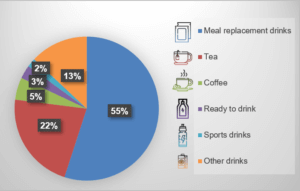
Figure 1: Drinks categories with slimming claims (drinks launched between 04/2019 and 06/2020) (Mintel, 2020)
The highest meal replacement drinks demands are in Asia Pacific (49% of the sales) (Euromonitor, 2020).
A majority of the drinks with slimming claims contain proteins (74%, which 38% contain more than 10% proteins) (Figure 2).
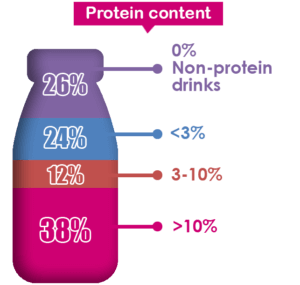
Figure 2: Protein-content of drinks with slimming claims (Mintel, 2020)
The rest of the weight management market is represented by 45% of food products (snack bars, breakfast cereals, bakery products…). 88% contain proteins.
It seems that a lot of the slimming products contain proteins. What are consumers’ thoughts about them?
In order to lose weight, many consumers pay more attention to the content of their diet. Some of them tend to increase their protein intake by having high-protein diets (Figure 3).

Figure 3: Increase of protein intake for weight loss goals in American, British and Chinese population (Mintel, 2016 )
70% of the general population recognizes the importance of having the right protein intake levels daily (FMCG Gurus, 2018).
Why are proteins a key component in weight management?
Proteins are mainly used for the following abilities:
- Increasing of satiety; this will help people who want to have a better management of their weight.5 6
- Proteins increase our energy expenditures.5
- Muscle gain; proteins are rich in all essential amino acids, including Leucin which function is to synthesize muscles. It also reduces lean body mass loss.5 7
Milk proteins are well adapted for weight management diets as they have an excellent amino-acid profile.
For more detailed information on proteins’ benefits on weight management, please refer to our last articles on weight management “The interest of proteins in weight management” and “The added interest of milk proteins for weight management”.
As mentioned previously, the weight management market growth is very low, due to more and more consumers turning to active nutrition.

Why are consumers shifting from weight management products to active nutrition?
Active nutrition is part of sports nutrition. The sports nutrition sales growth shows that it is a promising market with global sales of 12.7 billion dollar in 2018, and a growth of +8.4% (CAGR 2018-2023) (Euromonitor International, 2020).
Action nutrition can be defined as a “healthy lifestyle choice with the primary objective of optimizing both physical and mental performance”.8
In the past, products were specialized for weight management and were marketed for overweight people. Now, people want to maintain their weight and stay fit, as sport and nutrition are now recognised as pillars of wellness and take part of active people’s life balance. Consumers look for functional nutrients, such as proteins. 32% of adults aged 45-54 consider personal fitness to be an important part of their identity.9
Products that are generally launched in active nutrition are “on-the-go” products: “ready-to-drink” products, high protein bars and shakes.

Is weight loss a key component of sports nutrition?
Weight loss is a key component of sports nutrition marketing with high protein products, specially drinks. A survey of Euromonitor (2019) shows that the reasons for sports nutrition consumption differ for men and women. 36% of women and 26% of men consume nutritional products to lose weight. 37% of women and 45% of men look for strength and muscle tone. Women tend to look more for weight loss than men, to whom muscle tone is more important. Slogans can be observed on packaging, like the catch phrase “strong is the new skinny”.10
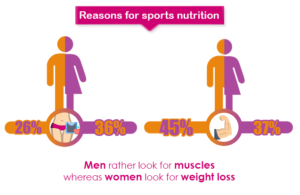
I need to gain weight. Are consuming proteins also beneficial for me?
Apart from wanting to lose weight or gain muscles, some people may also need to gain weight, such as seniors or undernourished people. It is recommended to use high protein drinks with high nutritional content to maintain weight and prevent sarcopenia.

To conclude, proteins are a key ingredient to manage weight. They can be used to lose, maintain or gain weight at a healthy level.
Nowadays weight management applies to any type of consumer, with high protein food and drinks as an excellent ally.
For more information and any inquiry, contact us.
Authors: Sandrine Tran & Elsa Trotier.
*BMI: Body Mass Index.
________________________________________________________________________________________________
[1] WHO, 2020. Obesity and overweight. https://www.who.int/news-room/fact-sheets/detail/obesity-and-overweight (consulted on 06.18.2020)
[2] WHO, 2019. To grow up healthy, children need to sit less and play more. https://www.who.int/news-room/detail/24-04-2019-to-grow-up-healthy-children-need-to-sit-less-and-play-more (consulted on 06.18.2020)
[3] Guignon N., et al., 2019. En 2017, des adolescents plutôt en meilleure santé physique mais plus souvent en surcharge pondérale. Direction de la recherche, des études, de l’évaluation et des statistiques. Volume 1122, August 2019. Pages 1-6. https://drees.solidarites-sante.gouv.fr/IMG/pdf/er1122.pdf (consulted on 06.18.2020)
[4] Euromonitor, 2018. Passport, New Visions of Weight Management: A 2018 Update on Trends and Innovations.
[5] Paddon-Jones, E. Westman, R.D. Mattes, R.R. Wolfe, A. Astrup, M. Westerterp-Plantenga, 2008. Protein, weight management, and satiety. The American Journal of Clinical Nutrition, Volume 87, Issue 5, May 2008, Pages 1558S–1561S. Pub May 01, 2008. https://doi.org/10.1093/ajcn/87.5.1558S (consulted on 17.06.2020)
[6] Soenen S., Westerterp-Plantenga, Margriet S., 2008. Proteins and satiety: implications for weight management. Clinical Nutrition and Metabolic Care. Vol 11:6, 747-751. Pub November 2008. https://doi.org/10.1097/MCO.0b013e328311a8c4 (consulted on 17.06.2020)
[7] Tappy, 1996. Thermic effect of food and sympathetis nervous system activity in humans. Reprod Nutr Dev. 36(4):391-7. Pub 1996.
[8] Euromonitor International, 2016. Passport. What is “Active Nutrition” and how can health and wellness players leverage the concept?
[9] Mintel, 2019. Optimum nutrition launches products geared towards adults 40%.
[10] Euromonitor, December 2018. Passport, New Visions of Weight Management: A 2018 Update on Trends and Innovations.
How can dairy products substitute meat products?
Because of environmental reasons, economics, or health, the current food trend is reduction of meat consumption. A lot of diets with little or no meat are very popular for several years. The most commons are flexitarianism (big reduction of meat consumption), vegetarianism (meat exclusion) or veganism (exclusion of all animal-based products). Therefore, according to a 2018 study conducted by the Credoc, consumption of meat products fell by 12% in France in only 10 years.1
However, for a lot of us, meat is or was our main proteins source. So, it is necessary to find different substitutes in order to provide our nutritional requirements. This is how dairy products can be a great substitute for flexitarian and vegetarian people!
Are dairy products good proteins source?
To answer this question, the best way is to look at a nutritional food composition table such the Ciqual, the French table from the ANSES.2 Data in figure 1 are taken from this database.
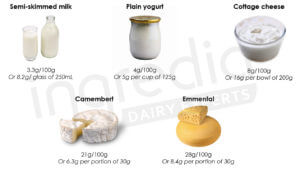
Figure n°1 : Protein amount in different portions of dairy products.2
If we compare data from figure with those of a meat product, for example a ground beef steak of 100g: it contains between 20 and 25g of proteins. A portion of Camembert (6.3g proteins) with a cottage cheese bowl of 200g (16g proteins) provide 22.3g of proteins. It represents as much proteins as the ground beef steak. Therefore, dairy products are a good proteins source to substitute meats.2
Are milk proteins of good quality?
Yes, they are proteins of excellent quality. Like meat proteins, they contain all the amino acids that make up our body’s proteins. As shown in figure 2 from a 2015 Journal of Nutrition article, they contain all essential amino acids A in good proportions: with 52g/100g of proteins, whey proteins are the higher in essential amino acids. Casein are in second position (48g/100g) just before beef or eggs (44g/100g). 3
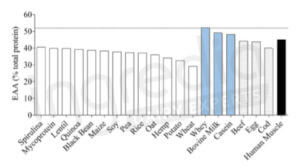
Figure n°2 : Essential amino acids (EAA) concentration of different proteins sources.3
White bars correspond to plant-based proteins, blue bars are milk proteins, grey bars are the other animal-based proteins (meat, fish, egg) and the black bar correspond to human muscle. The horizontal dashed line represents the highest concentration of essential amino acids found in the study, namely whey protein.
Are all essential amino acids as important?
Yes, they are. An essential amino acid can inherently not be synthesized by the body. The lack of any of them could have adverse effects on the body.
However, among these, an amino acid is particularly important to stimulate muscle protein synthesis: Leucine. This can be very interesting for athletes or elderly people.3 4 5 For more information about the interest of Leucine to stimulate anabolism B, take a look at our article “What is the perfect protein for the elderly people?” .
Figure 3 represents Leucine concentration of different proteins sources. We can see that milk proteins are the best Leucine source (11.7% for whey protein and 9.2% for caseins*). So, these proteins are perfectly adapted to people who want to maintain or strengthen their muscle mass.3
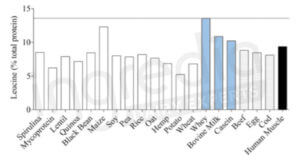
Figure n°3 : Leucine concentration in different proteins sources.3
Is the essential amino acids content the only parameter to be taken into account when judging the quality of a protein?
No, it is not. There is an indicator to evaluate the quality of a protein: the DIAAS (Digestible Indispensable Amino Acid Score). For a given protein, it considers the essential amino acids composition and the digestibility C of each of them.6 7 For more information about the DIAAS, do not hesitate to read our article dedicated to the quality of proteins.
According to the figure 4, which comes from a 2017 study conducted by S. Phillips, whole milk has a DIAAS about 1.14. In comparison, chicken breast has a DIAAS of 1.08 and beef meat is around 1.0 (DIAAS depends on digestibility of each essential amino acid of the protein, the cooking method of the meat can influence this data).8 9 The more a food has a high DIAAS, the more digestible the proteins it contains are, and the more it corresponds to the nutritional requirements. Consequently, we can note that milk proteins represent an excellent substitute to meat products.
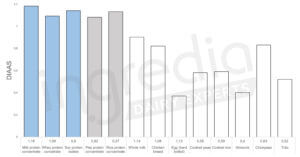
Figure n°4 : DIAAS of different foods and ingredients.8
White bars correspond to plant-based proteins, blue bars are milk proteins, grey bars are the other animal-based proteins (meat, egg).
Furthermore, figure 4 shows the two main drawbacks of plant-based proteins: on one hand they are globally not complete, on the other hand they are less digestible. That is the reason why these proteins never exceed a DIAAS of 1.0. For example, rice proteins are short of Lysine and Threonine, two essential amino acids not very present in cereals (particularly Lysine).10 And the digestibility of these proteins is about 55 to 65%.11 That is why DIAAS of cooked rice is only 0.59.12
Nevertheless, plant-based proteins should not be ignored. They can be better than meats on certain point, as figure 3 shown: maize has an excellent Leucine concentration (12.2%) which is nearly 40% higher than beef protein (8.8%).3 However, the lack of other essential amino acids can limit the previously mentioned beneficial effects of Leucine. It is therefore important to always vary its protein sources to properly cover its nutritional needs.
Compare to other proteins, only the benefits of milk proteins are presented. Are they really any better?
The answer is obviously no, there is no perfect food. Then, red meats retain an undeniable advantage: their high iron content.13 Red meats is one of the best iron sources of the traditional diet since 100g of cooked food cover 18 to 26% of iron daily needs. D On his side, milk only contains a very negligible amount of iron.14
Nevertheless, vegetarians can cover their iron needs with foods such as lentils. By comparison, 100g of cooked greed lentils can satisfy 15 to 22% of daily iron requirements (however, the bioavailability E of iron from plants is less important than iron from meats).2
Nota bene: Anemia, i.e. the lack of hemoglobin whose cause is multiple but often due to a lack of iron (dietary deficiency or malabsorption), concerns nearly a quarter of the world population (1.62 billion people) according to 2008 data from the WHO.15 If we choose to not consume meat anymore, then it is important pay attention to its daily consumption of iron and to focus on foods that provide enough iron (oilseed and legumes) and, if necessary, opt for iron rich food supplements (such as Lactoferrin).
However, concerning vitamins and minerals, milk is also very interesting: as beef meat, it is a good source of Phosphorus, Potassium, and vitamins B2, B5 and B12. Moreover, milk contains even more Calcium and vitamins B1 and B9.2 13 16
But in the end, how do you replace meat when you are used to having it on your plate?
For a lot of us, food traditions are rooted in our culture: a complete dish consists of meat and its sides (vegetables and starchy foods). But today, products imitating the look, the texture and sometimes even the taste of meat have appeared. These are meat analogues, or steak type. The best know are plant-based proteins steak type (soybeans, cereals, chickpeas, etc.) but is not uncommon for milk proteins to complement these meat analogues, particularly by addition of cheese. It is also possible to create meat analogue entirely with milk.
To conclude this article, it is perfectly possible to substitute meat products with a variety of animal-based (eggs and dairy products) and plant-based foods (cereals, legumes, oilseeds) to meet its protein requirements. Varying the sources ensures to cover its intake in all essential nutrients (amino acids, fatty acids, vitamins, minerals, etc.). That is the reason why the PNNS (French National Nutrition Health Plan) recommends a balance of 50% animal-based proteins and 50% plant-based proteins. In this sense, the new meat analogues composed of plant-based proteins and cheese appear to be a very good compromise.
For more information, please contact us
Authors: Rémi Maleterre & Audrey Boulier.
*A [Essential Amino Acids]: Amino acid that the body cannot synthesize. Therefore, they must be supplied through the diet
*B [Anabolism]: Muscular proteins synthesis.
*C [Digestibility]: For a given nutrient, this is the amount actually ingested available to the body after digestion and absorption. It can be expressed as a percentage.
*D [Daily iron requirements]: According to the ANSES, daily iron requirements are 11mg for men and postmenopausal women, and 16mg for premenopausal women
*E [Bioavailable]: relating to the absorption and used of a nutrient by the body. The more bioavailable a nutrient is, the more it is absorbed and used by the body.
*data for Leucine correspond to those measured in Prodiet® 90S for whey proteins and Prodiet® Fluid for micellar caseins. These products are developed by Ingredia.
_________________________________________________________________________________________
[1] Gabriel Tavoularis and Éléna Sauvage, “Les nouvelles générations transforment la consommation de viande,” Crédoc, September 1, 2018, https://www.credoc.fr/publications/les-nouvelles-generations-transforment-la-consommation-de-viande.
[2] ANSES, “Ciqual French Food Composition Table,” accessed April 7, 2020, https://ciqual.anses.fr/#.
[3] Stephan van Vliet, Nicholas A. Burd, and Luc J. C. van Loon, “The Skeletal Muscle Anabolic Response to Plant- versus Animal-Based Protein Consumption,” The Journal of Nutrition 145, no. 9 (September 2015): 1981–91, https://doi.org/10.3945/jn.114.204305.
[4] Imanipour Vahid et al., “The Effects of Branch-Chain Amino Acids on Fatigue in the Athletes,” Interventional Medicine & Applied Science 10, no. 4 (n.d.): 233–35, https://doi.org/10.1556/1646.10.2018.10.
[5] Chad M. Kerksick et al., “ISSN Exercise & Sports Nutrition Review Update: Research & Recommendations,” Journal of the International Society of Sports Nutrition 15, no. 1 (August 1, 2018): 38, https://doi.org/10.1186/s12970-018-0242-y.
[6] Food and Agriculture Organization of the United Nations, ed., Dietary Protein Quality Evaluation in Human Nutrition: Report of an FAO Expert Consultation, FAO Food and Nutrition Paper 92 (FAO Expert Consultation on Protein Quality Evaluation in Human Nutrition, FAO, 2011).
[7] Gertjan Schaafsma, “The Protein Digestibility–Corrected Amino Acid Score,” The Journal of Nutrition 130, no. 7 (July 1, 2000): 1865S-1867S, https://doi.org/10.1093/jn/130.7.1865S.
[8] Stuart M. Phillips, “Current Concepts and Unresolved Questions in Dietary Protein Requirements and Supplements in Adults,” Frontiers in Nutrition 4 (2017): 13, https://doi.org/10.3389/fnut.2017.00013.
[9] Suzanne M. Hodgkinson et al., “Cooking Conditions Affect the True Ileal Digestible Amino Acid Content and Digestible Indispensable Amino Acid Score (DIAAS) of Bovine Meat as Determined in Pigs,” The Journal of Nutrition 148, no. 10 (October 1, 2018): 1564–69, https://doi.org/10.1093/jn/nxy153.
[10] V. R. Young and P. L. Pellett, “Wheat Proteins in Relation to Protein Requirements and Availability of Amino Acids,” The American Journal of Clinical Nutrition 41, no. 5 Suppl (1985): 1077–90, https://doi.org/10.1093/ajcn/41.5.1077.
[11] Kunlun Liu, Jiabao Zheng, and Fusheng Chen, “Effect of Domestic Cooking on Rice Protein Digestibility,” Food Science & Nutrition 7, no. 2 (January 24, 2019): 608–16, https://doi.org/10.1002/fsn3.884.
[12] Brigid McKevith, “Nutritional Aspects of Cereals,” Nutrition Bulletin 29, no. 2 (2004): 111–42, https://doi.org/10.1111/j.1467-3010.2004.00418.x.
[13] ANSES, “Ciqual Table de Composition Nutritionnelle Des Aliments – La Viande Rouge, Cuite (Aliment Moyen),” accessed March 24, 2020, https://ciqual.anses.fr/#/aliments/6585/viande-rouge-cuite-(aliment-moyen).
[14] “Le Fer | Anses – Agence Nationale de Sécurité Sanitaire de l’alimentation, de l’environnement et Du Travail,” accessed March 24, 2020, https://www.anses.fr/fr/content/le-fer.
[15] Bruno De Benoist, World Health Organization, and Centers for Disease Control and Prevention (U.S.), Worldwide Prevalence of Anaemia 1993-2005 of: WHO Global Database of Anaemia (Geneva: World Health Organization, 2008), http://whqlibdoc.who.int/publications/2008/9789241596657_eng.pdf.
[16] ANSES, “Ciqual Table de Composition Nutritionnelle Des Aliments – Le Lait, Teneur En Matière Grasse Inconnue, UHT (Aliment Moyen),” accessed March 19, 2020, https://ciqual.anses.fr/#/aliments/19039/lait-teneur-en-matiere-grasse-inconnue-uht-(aliment-moyen).
What is the perfect protein for the elderly people?
Some health problems may arise and involve with age, especially at the muscular level. That is why a strength reduction and a muscular loss can appear. In the last article call “what are the protein need of the elderly people?” we emphasize the importance of consuming enough proteins to maintain and strengthen the muscular mass. Then this new article is made to identify the factors to be considered in order to know which proteins best meets elderly people needs.
What is the perfect protein for the elderly people?
The perfect protein does not exist, but some of these are most suitable than others. Animal based proteins should be privileged compared to plant based protein because of their balanced composition of essential amino acidsA and their excellent digestibility. By the way, food balance remains essential. That is the reason why it is recommended that animal based protein represent at least half of the daily protein intake.1 2 3
According to a report from the International Sarcopenia Initiative released in 2004, milk proteins seem to be the protein that best meet elderly people needs.1

How do milk proteins best meet elderly people needs?
In addition to amino acids composition and digestibility, a protein has to meet three requirements to be considered as suitable to supplement elderly diet. Therefore it must:
- Contain enough essential amino acids, especially BCAAB and more precisely Leucine ;
- Be easy to consume4 ;
- Sustainably promote muscle protein synthesis.5
Milk proteins meet these three criteria.6 7
Why are essential amino acids and BCAAs so important?
It is important to choose proteins high in essential amino acids in order to maximize muscle protein synthesis.8 Best sources of these ones are proteins which meets our organism needs with the best digestibility. This is explained in more detail in the article “How to characterize protein quality?”. The DIAAS is an indicator which takes into consideration the amino acid composition quality and there own digestibility. The higher the DIAAS is, the higher the protein quality is.9 Figure 1 is a bar chart representing DIAAS for different protein sources. We can see that milk proteins (casein, milk protein concentrate, whole milk powder, whey protein isolate, whey protain concentrate) have the higher DIAAS among all proteins.10
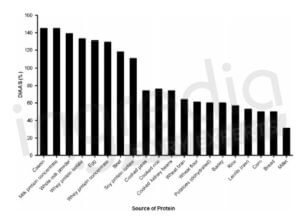
Figure 1: Quality of different common protein sources expressed with the DIAAS.10
However, it should not be forgotten that overall food intake is reduced for elderly people. Consequently, consumption of all amino acids is also reduced. Therefore, even if essential amino acids should be privileged, non essential ones should not be ignored.
Concerning BCAAs, these are essential amino acids with a positive impact on protein metabolism. They enhanced muscle protein synthesis and reduced degradation.5 Among the 3 different BCAAs we have Leucine. This is one of the most important amino acid to stimulate anabolismC.11 12
Many studies have been conducted to know the ideal dose of this amino acid necessary to stimulate muscle protein synthesis. A first one conducted in 2006 showed that quantity of Leucine necessary to have an optimal anabolic response for people over 60 years old was significantly higher than that required for young adults (respectively 2.8g vs. 1.7g).13
A review about nutritional recommendations of Medical Clinics of North America mentioned a minimum Leucine quantity of 2.2g per meal in order to enough stimulate anabolism.14
It is better to select a high Leucine protein source such as milk proteins. For example, micellar caseins contain 8.5% of Leucine. Therefore, a micellar caseins dose of 30g provides all essential amino acids necessary including 2.6g of Leucine. This is a sufficient dose to enhanced muscle protein synthesis, even for aged muscles.14
Is it really that important to choose easy to consume proteins?
For elderly people, it is necessary to promote anabolism period and limit muscle protein degradation as much as possible.
Overall catabolismD is promoted during periods far from meals, unlike anabolism which is stimulate after protein intake. Therefore it is essential to regularly consume protein.15
However, certain studies show that the most important point remains the total protein amount consume during the day, and not the timing or the distribution.16
At the same time, appetite reduction due to age must be considered. As a consequence, food quantity ingested deceases on average by 25% between the age of 40 and 70. This is the reason why 15 to 38% of the dependent elderly people (i.e. people in nursing home or assisted by a home nurse as a result of their independence loss) are affected by undernutrition in France.17
That is why it could be interested to spread food intake during the day and especially choosing an easy to consume protein source, for example in the form of a drink or a pudding. Milk proteins, particularly micellar caseins, are perfectly adapted for this type of formulation. Different food supplements exist, such as drink with up to 14g of protein in only 100mL of volume. This type of formulation provides a maximum of nutrients in a minimum of volume with a pleasant taste to make the product more palatable.18

Concerning the sustainable anabolism, what does it mean?
First, the protein dose should be sufficient to enhance muscle protein synthesis. The fact that an aged muscle is less responsive to a reduced amount of amino acid compared to a younger muscle has to be considered.19 This topic was explained in more detail in the article entitled “what are the protein need of the elderly people?”.
Secondly, the goal is to limit muscle protein degradation. To do so, two complementary solutions exist: reducing the time between meals and then increasing food intakes, and choose proteins gradually absorbed by the body in order to always have a concentration of blood amino acids higher than basal level.4
Concerning the meal increase, we return to what we described above: an easy to consume protein source remain necessary.4 About gradual absorption, micellar caseins have this property. This has been explain in the article “What is the interest of micellar caseins is sports?”.
Is this the only interest of milk proteins for the elderly people?
No it is not, these are only the main reasons. For example, to speak about an other interest, micellar caseins contain 2.6% of calcium, i.e. 2,600mg/kg! This is an excellent source of calcium which contribute to maintain the bone structure (risk reduction of osteoporosis) and muscle health. The article “what are the protein need of the elderly people?” explain this in more detail.

Did you know?
For elderly, especially people over 60, proteins are not the only nutrient to watch out. Overall food intake is reduced, then nutritional coverage of other nutrient may be lower than the needs, particularly iodine, zinc, omega-3 (EPA and DHA) and, only for women, iron and vitamin C. These data come from a report established by the ANSES in june 2019.20
A food supplement for elderly people should consider some of these nutrients in order to be as complete as possible.
For more information on our milk proteins and our expertise, contact us.
Authors: Rémi Maleterre & Audrey Boulier.
*A [Essential Amino Acids]: Amino acid that the body cannot synthesize. Therefore they must be supplied through the diet.
*B [BCAA, Branched-Chain Amino Acids]: Essential amino acids which correspond to Leucine, Isoleucine and Valine
*C [Anabolism]: Muscular protein synthesis.
*D [Catabolism]: Muscular protein degradation.
________________________________________________________________________________________________
[1] Cruz-Jentoft AJ, Landi F, Schneider SM, Zúñiga C, Arai H, Boirie Y, Chen LK, Fielding RA, Martin FC, Michel JP, Sieber C, Stout JR, Studenski SA, Vellas B, Woo J, Zamboni M, Cederholm T (2014) Prevalence of and interventions for sarcopenia in ageing adults: a systematic review. Report of the International Sarcopenia Initiative
[2] Paddon-Jones D., Leidy H. (2014). Dietary protein and muscle in older persons. Current opinion in clinical nutrition and metabolic care vol. 17, 1:5-11. Epub September 12, 2014. https://doi.org/10.1097/MCO.0000000000000011
[3] Marzetti E., Calvani R., Tosato M., Cessari M., Di Bari M., Cherubini A., Collamati A., D’Angela E., Pahor M., Bernabel R., Landi F. (2017). « Sarcopenia: An Overview ». Aging Clinical and Experimental Research, vol. 29, no 1, p. 11‑17. Epub February 2, 2017. https://doi.org/10.1007/s40520-016-0704-5
[4] Kerksick C.M., Wilborn C.D., Roberts M.D., Smith-Ryan A., Kleiner S.M., Jäger R., Collins R., Cooke M., Davis J.N., Galvan E., Greenwood M., Lowery L.M., Wildman R., Antonio J. and Kreider R.B. (2018). ISSN exercise & sports nutrition review update: research & recommandations. Journal of the International Society of Sports Nutrition, 15:38. Epub August 01, 2018. https://doi.org/10.1186/s12970-018-0242-y
[5] Lacroix M., Bos C., Léonil J., Airinei G., Luengo C., Daré S., Benamouzig R., Fouillet H., Fauquant J., Tomé D., Gaudichon C. (2018). Compared with casein or total milk protein, digestion of milk soluble proteins is too rapid to sustain the anabolic postprandial amino acid requirement. Am J Clin Nutr 2006; 84:1070–9/ Epub January 23, 2018. https://doi.org/10.1556/1646.10.2018.10
[6] Ingredia. Prodiet 87 B Fluid – Nutrition facts . December 11, 2015.
[7] Ingredia. Prodiet 90 S – Nutrition facts . March 18, 2016.
[8] Atherton P.J., Smith K. (2012). Muscle protein synthesis in response to nutrition and exercise. J Physiol, 590(5):1049–1057. Epub January 31, 2012. https://doi.org/10.1113/jphysiol.2011.225003
[9] Report of an FAO Experte consultation. Dietary protein quality evaluation in human nutrition. ISSN 0254-4725 FAO and food nutrition paper 92. 31 March – 2 April, 2011.
[10] Robert R. Wolfe, Update on protein intake: importance of milk proteins for health status of the elderly, Nutrition Reviews, Volume 73, Issue suppl_1, August 2015, Pages 41–47. Epub July 11, 2015. https://doi.org/10.1093/nutrit/nuv021
[11] Imanipour V., Banaiifar A., Mahdi F., Naderi A., Sadeghi M. (2018). The effects of branch-chain amino acids on fatigue in the athletes. Interventional Medicine and Applied Science 2061-5094. Epub March 19, 2018. https://doi.org/10.1556/1646.10.2018.10
[12] J.C. Anthony, T.G. Anthony, S.R. Kimball, T.C. Vary, L.S. Jefferson (2000). Orally Administered Leucine Stimulates Protein Synthesis in Skeletal Muscle of Postabsorptive Rats in Association with Increased eIF4F Formation, The Journal of Nutrition, Volume 130, Issue 2. Pages 139–145. Epub February 01, 2000. https://doi.org/10.1093/jn/130.2.139
[13] C.S. Katsanos, H. Kobayashi, M. Sheffield-Moore, A. Aarsland, R.R Wolfe (2006). A high proportion of leucine is required for optimal stimulation of the rate ofmuscle protein synthesis by essential amino acids in the elderly. Am J Physiol Endocrinol Metab 2006;291(2):E381–7. Epub August 01, 2006. https://doi.org/10.1152/ajpendo.00488.2005
[14] Hope Barkoukis (2016). Nutritions recommendations in elderly and Aging. Practice-base nutrition Care, Medical clinics of North America. Vol 100, number 6, 1237-1250. Pub November 2016.
[15] Poortmans, J.R., Carpentier, A., Pereira-Lancha, L.O., & Lancha Jr., A. (2012). Protein turnover, amino acid requirements and recommendations for athletes and active populations. Brazilian Journal of Medical and Biological Research, 45(10), 875-890. Epub June 06, 2012.https://dx.doi.org/10.1590/S0100-879X2012007500096
[16] I.Y. Kim, S. Schutzler, A.M. Schrader, H.J. Spencer, G. Azhar, R.R. Wolfe, A.A. Ferrando (2018). Protein intake distribution pattern does not affect anabolic response lean body mass, muscle strength or function over 8 weeks in older adults: a randomize-controlled trial. Clinical Nutrition, Vol 37, Issue 2, 488-493. Epub Avril 2018. https://doi.org/10.1016/j.clnu.2017.02.020
[17] V. Pouyet, A. Giboreau, G. Cuvelier, L. Benattar (2015). Les préférences culinaires des personnes âgées vivant en institution : facteurs d’appréciation sensoriels et cognitifs. Cahier de Nutrition et Diététique 2015. Vol 50, n°5, p235-289. Pub November 2015. https://doi.org/10.1016/j.cnd.2015.03.008
[18] Ingredia, Prodiet Fluid. The Innovative Micellar Casein dedicated to high protein beverages. https://www.prodiet-fluid.com/
[19] D. Dardevet, D. Rémond, M.A. Peyron, I. Papet, I. Savary-Auzeloux, L. Mosoni (2012). Muscle wasting and resistance of muscle anabolisme : the « anabolic threshold concept » for adapted nutritional strategies during sarcopenia. The Scientific World Journal, Vol 2012, ID 269531. Epub December 03, 2012. https://dx.doi.org/10.1100/2012/269531
[20] Agence nationale de sécurité sanitaire de l’alimentation, de l’environnement et du travail (ANSES). (2019) Dossier de presse – Repères alimentaires pour populations spécifiques. Consulté le 2 juillet 2019. https://www.anses.fr/fr/content/rep%C3%A8res-alimentaires-pour-les-populations-sp%C3%A9cifiques-enfants-femmes-enceintes-allaitantes
What are the protein needs of the elderly?
There are some complications due to age. One of these is the muscular mass loss which can significantly affect quality of life by limiting mobility.
From what age do we consider these muscle problems?
Overall, there are three age categories to define:
- The middle-age, i.e. people between 40 and 65 years old. Muscular loss is still minimal and it is especially important to act PREVENTIVELY;
- The pre-elderly between 65 and 75 years old. Certain muscular problems can occur and the goal will be to PREVENT and TREAT them ;
- The elderly, which are over the age of 75. Muscular problems are more important. More age-related diseases can take a hold but it is still possible to TREAT them.
The aim is then to determine how the lifestyle modification can prevent and limit muscular diseases development due to age.
How do these age-related complications occur?
As from the age of 40 to 50 years old, a reduction of muscular mass and physical abilities begins to appear. It represents a loss from 3 to 8% of muscular mass every 10 years depending on the lifestyle1 2. This is the potential beginning of sarcopenia, i.e. the age-related muscular mass loss which is a multifactorial disease (figure 1) 3.
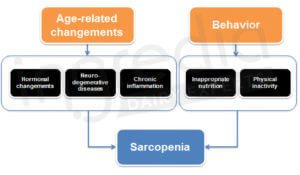
Figure 1: Main causes of sarcopenia
It is essential to react as soon as possible to avoid falling into the vicious circle of sarcopenia (figure 2). In order to do this, we can act on the behavioral causes (figure 1), especially on nutrition and physical activity 3.
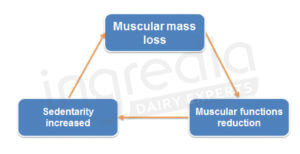
Figure 2: The ‘vicious circle’ of sarcopenia
Can we act through a diet modification?
Yes, we can. The following recommendations allow prevention and treatment of age-related muscular troubles (like sarcopenia). These must be followed from middle-age on.
In order to stimulate anabolism* of old muscle, an increased protein dose is necessary in comparison to younger muscles. A 2012 study has shown that a small quantity of about 5g of proteins was sufficient to trigger anabolism for young adults. A maximal answer was observed from approximately 20g. While for elderly, a quantity twice as important was needed for the same results (i.e. between 30 and 40g for a maximal answer, as shown in the figure 3) 4 5 6 7. This phenomenon has also been shown during a 2015 meta-analysis: the protein amount necessary to contribute to an optimal anabolism is 0.24g/kg of the bodyweight per meal for the young people and 0.40g/kg for the elderly 8. Hence the importance of increasing the protein intake for the elderly.
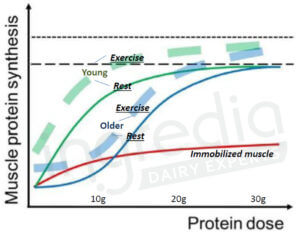
Figure 3: Muscular protein synthesis in function of the ingested protein dose for the young people (green curves) and the elderly (blue curves) 4 .
The full curves correspond to anabolism observed for muscle at rest, and the dotted curves for muscle after a physical activity.
The most important point is to provide enough proteins to the body in order to increase the muscular protein synthesis. 1.2g of proteins per kilogram of the bodyweight per day is a minimum to maintain muscular mass and improve physical abilities 2 9 10. Certain studies show that it would even be useful to consume a protein amount up to 1.5g/kg/d to ensure an efficient maintenance of muscular functions 11 12 13. However protein intake recommendations at the adulthood are 0.8g/kg/d. Then, the aim would be to double these daily recommendations. So it can be hard to consume that many proteins especially if the appetite decreases. That is the reason why protein supplements can represent a good alternative to cover protein needs in the case of malnutrition under medical supervision5.
Is it really necessary for elderly to consume that much protein?
Yes, it is. We often imagine that a high protein diet can cause kidney complications. However, no study currently shows that a high protein diet will create this kind of problems in healthy people 14. Nevertheless, a high protein diet is not recommended for people with known kidney problems or predispositions. In this case, protein consumption higher than 0.8g/kg/d can be harmful for certain people 15.
Is protein alone enough or is physical activity necessary?
Physical activity is the stimulus which enhances muscular protein synthesis. The figure 4 comes from a study of 2013 which compare anabolism depending on the ingested protein dose (whey in this study) and the physical activity. We can note that exercise allows a significant increase of the anabolism level 16.
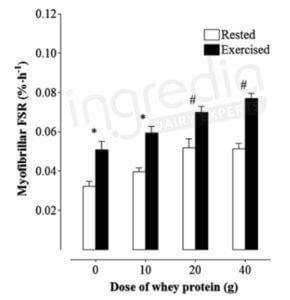
Figure 4: Muscular protein synthesis depending on the amount of protein ingested and the physical activity13.
The Myofibrillar FSR (Fractional Synthetic Rate) corresponds to the anabolism rate.
Most researches seem to indicate that a protein supplementation without exercise does not allow a sustainable muscular mass increase of the elderly 3 17. Therefore, protein supplementation alone seems to be insufficient. This led the World Health Organization to recommend that people over 65 years old do at least 150 minutes of endurance activity at a moderate intensity, or 75 minutes at high intensity each week. It is also advised to do muscle strengthening exercises at least twice a week18.
We talk a lot about proteins, but are they the only nutrients to bring in greater quantities?
No, they are not. Micronutrients are also important, especially calcium and vitamin D. An adequate intake of these contributes to the muscular mass and strength maintenance. Moreover calcium and vitamin D are essential to ensure bone capital maintenance 19.
First, let us review about the bone capital: there is a mechanism of turnover similar to the protein one. Overall, until the age of about 50, bone density stay constant because of the balance between synthesis and degradation. However, after 50 years old, degradation can exceed synthesis. Then bone density reduction can occur. A lack of treatment can lead to osteoporosis. Bones become porous and brittle, increasing the risk of fracture. If we add a potential muscular mass and strength reduction caused by sarcopenia, then we have a consequent increase of serious falls. This can lead to major mobility problems 20.
An increase in vitamin D and calcium consumption can ensure a better maintenance of its bone and muscular capital. But under-consumption of vitamin D is frequent: recommended daily intakes provided by the ANSES (French agency of food safety) are 15µg for adults. However, the average consumption is about 3.1µg/d in France, which is 5 times lower than ANSES recommendations! So it is necessary to provide more vitamin D in order to fill that potential gap 21.
For calcium, it is recommended to consume between 900 and 1200mg per day for people over 50 years old. The average daily consumption is sufficient but not excessive since it is about 900mg. Therefore it is important to make sure that the diet is sufficiently rich in calcium 22.
Alright, then what food should we eat?
It is a very valid question because all proteins are not equivalent. It is necessary to choose a source of good quality proteins corresponding to our needs. And this will be the topic of the next article. It will detail the interest of milk proteins to prevent sarcopenia.
For more information on our milk proteins and our expertise, contact us.
Authors: Rémi Maleterre & Audrey Boulier.
* [Anabolism] : Muscular protein synthesis.
________________________________________________________________________________________________
[1] Paddon-Jones D., Leidy H. (2014). Dietary protein and muscle in older persons. Current opinion in clinical nutrition and metabolic care vol. 17, 1:5-11. Epub September 12, 2014. https://doi.org/10.1097/MCO.0000000000000011
[2] Marzetti E., Calvani R., Tosato M., Cessari M., Di Bari M., Cherubini A., Collamati A., D’Angela E., Pahor M., Bernabel R., Landi F. (2017). « Sarcopenia: An Overview ». Aging Clinical and Experimental Research, vol. 29, no 1, p. 11‑17. Epub February 2, 2017. https://doi.org/10.1007/s40520-016-0704-5
[3] Cruz-Jentoft A.J., Bahat G., Bauer J., Boirie Y., Bruyère O., Cerderholm T., Cooper C., Landi F., Rolland Y., Sayer A.A., Schneider S.M., Sieber C.C., Topinkova E., Vandewoude M., Visser M., Zamboni M. (2018). Sarcopenia: revised European consensus on definition and diagnosis. Report of the European Working Group on Sarcopenia in Older People. Age Ageing. 39(4): p. 412-23. Epub January 01, 2019. https://doi.org/10.1093/ageing/afy169
[4] D. Dardevet, D. Rémond, M.A. Peyron, I. Papet, I. Savary-Auzeloux, L. Mosoni (2012). Muscle wasting and resistance of muscle anabolisme : the « anabolic threshold concept » for adapted nutritional strategies during sarcopenia. The Scientific World Journal, Vol 2012, ID 269531. Epub December 03, 2012. https://dx.doi.org/10.1100/2012/269531
[5] K. Dideriksen, S. Reitelseder, L. Holm (2013). Influence of amino acids dietary protein and physical activity on muscle mass development in humans. Nutrients 2013, 5(3), 852-876. Epubl March 13, 2013. https://doi.or/10.3390/nu5030852
[6] D. Tomé (2018 – Lille, France) – Protein Digestibility Scores & Nutrition, AgroParisTech – Departement of Life Sciences and Health; INRA, UMR Nutrition physiology and ingestive behavior.
[7] Moore DR, Robinson MJ, Fry JL, Tang JE, Glover EI, Wilkinson SB, Prior T, Tarnopolsky MA, Phillips SM. Ingested protein dose response of muscle and albumin protein synthesis after resistance exercise in young men. Am J Clin Nutr 2009;89(1):161–8.
[8] Moore DR, Churchward-Venne TA, Witard O, Breen L, Burd NA, Tipton KD, Phillips SM. Protein ingestion to stimulate myofibrillar protein synthesis requires greater relative protein intakes in healthy older versus younger men. J Gerontol A Biol Sci Med Sci 2015;70(1):57–62.
[9] Cruz-Jentoft AJ, Landi F, Schneider SM, Zúñiga C, Arai H, Boirie Y, Chen LK, Fielding RA, Martin FC, Michel JP, Sieber C, Stout JR, Studenski SA, Vellas B, Woo J, Zamboni M, Cederholm T (2014) Prevalence of and interventions for sarcopenia in ageing adults: a systematic review. Report of the International Sarcopenia Initiative (EWGSOP and IWGS). Age Ageing 43:748–759. doi:10.1093/ageing/afu115
[10] Traylor D.A., Gorissen S.HM, Phllips S.M. (2018). Perspective: protein requirements and optimal intakes in aging: are we ready to recommend more than the recommended daily allowance? Advances in Nutrition, Volume 9, Issue 3, Pages 171–182. Epub May 15, 2018. https://doi.org/10.1093/advances/nmy003
[11] Murphy CH, Saddler NI, Devries MC, McGlory C, Baker SK, Phillips SM. Leucine supplementation enhances integrative myofibrillar protein synthesis in free-living older men consuming lower- and higher-protein diets: a parallel-group crossover study. Am J Clin Nutr 2016;104(6):1594–606
[12] Kim IY, Schutzler S, Schrader A, Spencer H, Kortebein P, Deutz NE, Wolfe RR, Ferrando AA. Quantity of dietary protein intake, but not pattern of intake, affects net protein balance primarily through differences in protein synthesis in older adults. Am J Physiol Endocrinol Metab 2015;308(1):E21–8.
[13] Mitchell CJ, Milan AM, Mitchell SM, Zeng N, Ramzan F, Sharma P, Knowles SO, Roy NC, Sjodin A, Wagner KH, et al. The effects of dietary protein intake on appendicular lean mass and muscle function in elderly men: a 10-wk randomized controlled trial. Am J Clin Nutr 2017;106(6):1375–83.
[14] M. Cuenca-Sánchez, D. Navas-Carrillo, E. Orenes-Piñero (2015). Controversies Surrounding High-Protein Diet Intake: Satiating Effect and Kidney and Bone Health, Advances in Nutrition, Volume 6, Issue 3, May 2015, Pages 260–266. Epub May 2015. https://doi.org/10.3945/an.114.007716
[15] M.C. Huang, M.E Chen, H.C. Hung, H.C. Chen, W.T. Chang, C.H. Lee, Y.Y. Wu, H.C. Chiang, S.J. Hwang (2008). Inadequate energy and excess protein intakes may be associated with worsening renal function in chronic kidney disease. J Ren Nutr 2008;18:187–94. Epub March 2008. https://doi.org/10.1053/j.jrn.2007.08.003
[16] O.C. Witard, S.R. Jackman, L. Breen, K. Smith, A. Selby, K.D. Tipton (2014). Myofibrillar muscle protein synthesis rates subsequent to a meal in response to increasing doses of whey protein at rest and after resistance exercise, The American Journal of Clinical Nutrition, Volume 99, Issue 1, Pages 86–95. Pub January 2014. https://doi.org/10.3945/ajcn.112.055517
[17] Tieland M, van de Rest O, Dirks ML et al. Protein supplementation improves physical performance in frail elderly people: a randomized, double-blind, placebo-controlled trial. J Am Med Dir Assoc 2012b; 13: 720–6. Epub October 2012. https://doi.org/10.1016/j.jamda.2012.07.005
[18] OMS (Organisation Mondiale de la Santé), « L’activité physique des personnes âgées » [consulté le 01 juillet 2019]. https://www.who.int/dietphysicalactivity/factsheet_olderadults/fr/
[19] B. Hamilton (2010). Vitamin D and Human Skeletal Muscle. Scand J Med Sci Sports. 20:182-190. E pub July 8, 2019. https://doi.or/10.1111/j.1600-0838.2009.01016.x
[20] J.A. Kanis, L.J. Melton, C. Christiansen, C.C. Johnston, N. Khaltaev (1994). The diagnosis of osteoporosis. Journal of bone and mineral research. Vol 9:8. Pub August 1994. https://doi.org/10.1002/jbmr.5650090802
[21] National agency of food safety, environment and work (ANSES). (2019) Vitamine D: presentation, besoins nutritionnels et sources alimentaires. At : https://www.anses.fr/fr/content/vitamine-d
[22] National agency of food safety, environment and work (ANSES). (2019) Le Calcium: presentation, sources alimentaires et besoins nutritionnels. At : https://www.anses.fr/fr/content/le-calcium
How to characterize protein quality?
Proteins are essential for our body. While being mainly known for their role as fundamental building blocks for muscles, these proteins compose only half of those present in the body. Skins, hair, sinews, some hormones, etc. all of these are composed of proteins. And proteins have many other applications in the body.
Are some protein sources better than others?
Yes there are. All the proteins in our diet are not equivalent. Each and every one is composed of a different amino acid chain and has its own structure. Therefore the quality of certain proteins will be a better match to our bodily needs thanks to their high digestibility and amino acids composition1.
How do we know which proteins are better?
The first thing to look at is the amino acids composition of the protein: the bigger the ratio of essential amino acids A is, the better the nutritional interest is.
The Chemical Score (CS) is used to evaluate this parameter. It is defined by comparing the essential amino acids ratio of the studied protein with the reference protein of the FAO1, which is considered as “ideal”: it contains all essential amino acids in the minimum necessary proportion for the body. Consequently its chemical score has been fixed at 1002.
To calculate the chemical score, we have to consider the essential amino acid with the lowest concentration and compare it with the reference protein of the FAO. So only the amino acid called the limiting amino acid is concerned.
A chemical score below 100 means that the studied protein has at least one essential amino acid present in insufficient number. Meanwhile if all essential amino acids are presents in higher quantities than the minimal bodily needs, then the chemical score will be higher than 100. It demonstrates a high quality protein1 2.
We can be more accurate in the essential amino acids composition study by looking at the BCAAB concentration. They are approximately 35% of muscles essential amino acids 3. An therefore they are necessary to protein muscle synthesis. Moreover, BCAA can be used as an energy source by muscles, especially during an intense effort4. As a result, a person’s diet has to provide enough BCAA, even more so for athletes 5.
So, does only essential amino acids composition define protein quality?
No it does not. Another parameter is important to consider: the protein digestibility. It corresponds to the amount of ingested protein which is effectively available for the body after digestion and absorption.
Digestibility can be measured in the ileum (small intestine last section) or in the feces (cf. figure 1). The first method is more accurate if we want to know the real amount of amino acids absorbed, but it is harder to use in Humans. Therefore the second method is more in use2.
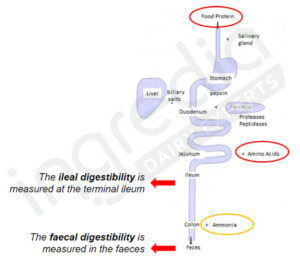
Figure 1: Ileal and faecal digestibility2
So we have two different data which give different information… Is their any indicator that would combine both information?
Yes there is, and it is called the PDCAAS (Protein Digestibility-Corrected Amino Acid Score). This indicator has been published by the FAO in 1991 and it considers essential amino acids composition and faecal digestibility 1 2:
The PDCAAS is scaled from 0 (bad protein quality and/or indigestible) and 1 (high quality and digestible protein). If a result is higher than 1, then it is set to 1.
All amino acids do not have the same digestibility. Is there a more accurate indicator?
This is true; each amino acid is assimilated differently by the body. That’s why the FOA has published a new indicator in 2013, the DIAAS (Digestible Indispensable Amino Acid Score). It considers the ileal digestibility of each amino acid, which is more accurate than the global faecal digestibility used for the PDCAAS 1 2.
What are the best proteins?
We need to distinguish proteins by their origin: from plants and from animals.
Animal based proteins usually have a well balanced essential amino acids profile and consequently a high chemical score. On the opposite, plant based proteins have often one or several limiting amino acids, reducing their chemical score. Figure 2 give some examples of chemical scores2 6 7 8 9.
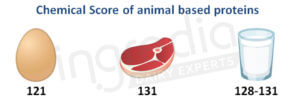
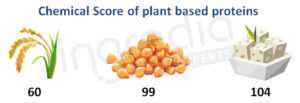
Figure 2: Example of chemical scores of proteins 2 6 7 8 9
As far as the digestibility is concerned, plant based proteins (70 to 90%) usually have a lower score than animal based proteins (91 to 99%)2. As a consequence, if we consider the PDCASS or the DIAAS which include essential amino acids composition of the protein and its digestibility, it is not a surprise if the protein quality indicator is higher for animal based proteins than for plant based proteins (table 1).
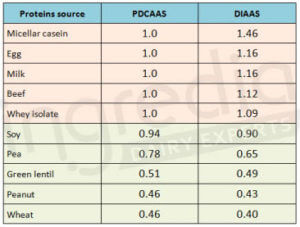
Table 1: Ranking of different protein sources based on PDCAAS and DIAAS 1 10 11 12 13 20 21
All of this is very technical… What are the pros and cons of each protein.
First, let’s have a look at animal based proteins. They have a great amino acids composition. So they are interesting for every category of people: the average adults, the growing children, the athletes who would like to improve their performances, and also the elderlies who want to maintain their muscle mass. These proteins are particularly interesting for these last two categories, since certain studies show that they are more efficient to stimulate muscle protein synthesis and to reduce protein breakdown 6 14 15. The drawback of animal based proteins can be found in meat, fishes and eggs, is that these products, with the exception of milk, are often sources of fat, more particularly saturated fats and cholesterol which excessive consumption can lead to adverse long-term health effect 6.

Plant based proteins often have one limiting amino acid. This is the reason why it is recommended for vegetarians and vegans to diversify their protein sources for their diet to provide all essential amino acids. Globally, leguminous plants (lentils, peas, …) have a sulfur amino acids deficit (Methionin and Cystein) and cereals do not have enough Lysin. Combining these two protein sources can be a good strategy. The main advantage of plant based proteins is that vegetables are a good sources of dietary fibers, vitamins and minerals, which have beneficial health effects. Another interesting plant protein source is soy because it presents a good amino acids profile and a good digestibility. It could be a protein able to compete with animal based proteins, however soy contains isoflavones, a molecule which mimic the actions of estrogens, a gender related hormone mainly present in female anatomy. Therefore in high amount, isoflavones can potentially lead to hormonal disorders. This risk caused certain studies to recommend avoiding the use of soy products for child nutrition 2 6 11 16

The best compromise would seem to be milk proteins: whey and micellar caseins. Like the other animal proteins, they present a well balanced amino acids composition and are a good source of BCAA. Moreover they contain a lot of bioactive peptides – i.e. short amino acids chains which have biological effects such as stress reduction 6 17 18. Digestibility-wise, our body reacts differently to whey and micellar caseins. As a result they are complementary 19.
Today, the easy access to large food diversity allows us to select product with the best quality. So for proteins it is important to understand which parameters can define their quality. This allows us to know what the best proteins are for our needs and our lifestyle. Regarding milk proteins, Ingredia is committed to the use of the best raw material and the least denaturing processes. In order to better preserve the native structure of the proteins.
For more information, please contact us
Authors: Rémi Maleterre & Audrey Boulier.
*A [Essential Amino Acids]: Amino acid that the body cannot synthesize. Therefore they must be supplied through the diet.
*B [BCAA, Branched-Chain Amino Acids]: Essential amino acids which correspond to Leucine, Isoleucine and Valine.
_________________________________________________________________________________________
[1] Report of an FAO Experte consultation. Dietary protein quality evaluation in human nutrition. ISSN 0254-4725 FAO and food nutrition paper 92. 31 March – 2 April, 2011.
[2] D. Tomé (2018 – Lille, France) – Protein Digestibility Scores & Nutrition, AgroParisTech – Departement of Life Sciences and Health; INRA, UMR Nutrition physiology and ingestive behavior.
[3] A.E. Harper, R. H. Miller, K. P. Block (1984). Branched-Chain Amino Acid Metabolism. Annual review of Nutrition. Vol. 4:409-454. Epub July, 1984. https://doi.org/10.1146/annurev.nu.04.070184.002205
[4] M. J. Rennie (1996). Influence of Exercise on Protein and Amino Acid Metabolism. Handbook of Physiology, exercise: regulation and integration of multiple systems. Epub January, 2011. https://doi.org/10.1002/cphy.cp120122
[5] Y. Shimomura, T. Murakami, N. Nakai, M. Nagasaki, R. A. Harris (2004). Exercise Promotes BCAA Catabolism: Effects of BCAA Supplementation on Skeletal Muscle during Exercise, The Journal of Nutrition, Volume 134, Issue 6, Pages 1583S–1587S. Epub Octobor 01, 2004. https://doi.org/10.1093/jn/134.6.1583S
[6] J.R. Hoffman, and M.J. Falvo. (2004). Protein – Which is Best?. Journal of sports science & medicine vol. 3,3 118-30. Epub September 01, 2004.
[7] Protein Quality Evaluation, Report of the Joint FAO/WHO Consultation. Expert Consultation Bethesda, Md., USA. 4-8 December 1989.
[8] Ingredia. Prodiet 87 B Fluid – Nutrition facts. December 11, 2015.
[9] Ingredia. Prodiet 90 S – Nutrition facts. March 18, 2016.
[10] J.K. Mathai, Y. Liu, H.H. Stein (2017). Values for digestible indispensable amino acid scores (DIAAS) for some dairy and plant proteins may better describe protein quality than values calculated using the concept for protein digestibility-corrected amino acid scores (PDCAAS). Br J Nutr. 117(4):490-499. Epub February, 2017. https://doi.org/10.1017/S00D7114517000125
[11] M. Jarpa-Parra (2017). Lentil protein: a review of functional properties and food application. An overview of lentil protein functionality. International Journal of Food Science & Technology. Vol 53, issue 4. Epub November 21, 2017. https://doi.org/10.1111/ijfs.13685
[12] S.M. Rutherfurd, A.C. Fanning, B.J. Miller, P.J. Moughan (2015). Protein digestibility-corrected amino acid scores and digestible indispensable amino acid scores differentially describe protein quality in growing male rats. J Nutr. 145(2):372-9. Epub February, 2015. https://doi.org/10.3945/jn.114.195438
[13] M.G. Nosworthy, J. Neufeld, P. Frohlich, G. Young, L. Malcolm, J.D. House (2017). Determination of the protein quality of cooked Canadian Pulses. Food Science & Nutrition. Epub June 20, 2017. https://doi.org/10.1002/fsn3.473
[14] W.W. Campbell, M.L. Barton Jr., D. Cyr-Campbell, S.L. Davey, J.L. Beard, G. Parise, W.J. Evans (1999). Effects of an omnivorous diet compared with a lactoovovegetarian diet on resistance-training-induced changes in body composition and skeletal muscle in older men. American Journal of Clinical Nutrition 70, 1032-1039. Pub December 01, 1999. https://doi.org/10.1093/ajcn/70.6.1032
[15] D.L.E. Pannemans, A.J.M. Wagenmakers, K.R. Westerterp, G. Schaafsma, D. Halliday (1998). Effect of protein source and quantity on protein metabolism in elderly women. American Journal of Clinical Nutrition 68, 1228-1235. Pub December 01, 1999. https://doi.org/10.1093/ajcn/68.6.1228
[16] C.R. Cederroth, J. Auger, C. Zimmermann, F. Eustache, S. Nef (2010). Soy, phyto-oestrogens and male reproductive function: a review. International Journal of Andrology, Vol 3, Issue 2. Epub March 14, 2010. https://doi.org/10.1111/j.1365-2605.2009.01011.x
[17] C.M. Kerksick, C.D. Wilborn, M.D. Roberts, A. Smith-Ryan, S.M. Kleiner, R. Jäger, R.Collins R., Cooke M., Davis J.N., Galvan E., Greenwood M., Lowery L.M., Wildman R., Antonio J. and Kreider R.B. (2018). ISSN exercise & sports nutrition review update: research & recommandations. Journal of the International Society of Sports Nutrition, 15:38. Epub August 01, 2018. https://doi.org/10.1186/s12970-018-0242-y
[18] Y.W. Park, M.S. Nam (2015). Bioactive peptides in milk and dairy products: a review. Korean Journal for Food Science of Animal Resources, 35: 831–840. Epub December 31, 2015. https://doi.org/10.5851/kosfa.2015.35.6.831
[19] M. Lacroix, C. Bos, J. Léonil, G. Airinei, C. Luengo, S. Daré, R. Benamouzig, H. Fouillet, J. Fauquant, D. Tomé, C. Gaudichon (2018). Compared with casein or total milk protein, digestion of milk soluble proteins is too rapid to sustain the anabolic postprandial amino acid requirement. Am J Clin Nutr 2006; 84:1070–9/ Epub January 23, 2018. https://doi.org/10.1556/1646.10.2018.10.
[20] A. Ogawa, H. Murayama, K. Hayamizu, Y. Kobayashi, M. Kuwahata, Y. Kido (2015). A simple evaluation method for the quality of dietary protein in rats using an Indicator Amino Acid Oxidation technique. J Nutr Sci Vitaminol, 61(2):123-30. Pub 2015. https://doi.org/10.3177/jnsv.31.123
[21] R.R. Wolfe (2015). Update on protein intake: importance of milk proteins for health status of the elderly. Nutrition Reviews, 73(Suppl 1):41-47. Pub August 2015. https://doi.org/10.1093/nutrit/nuv021
